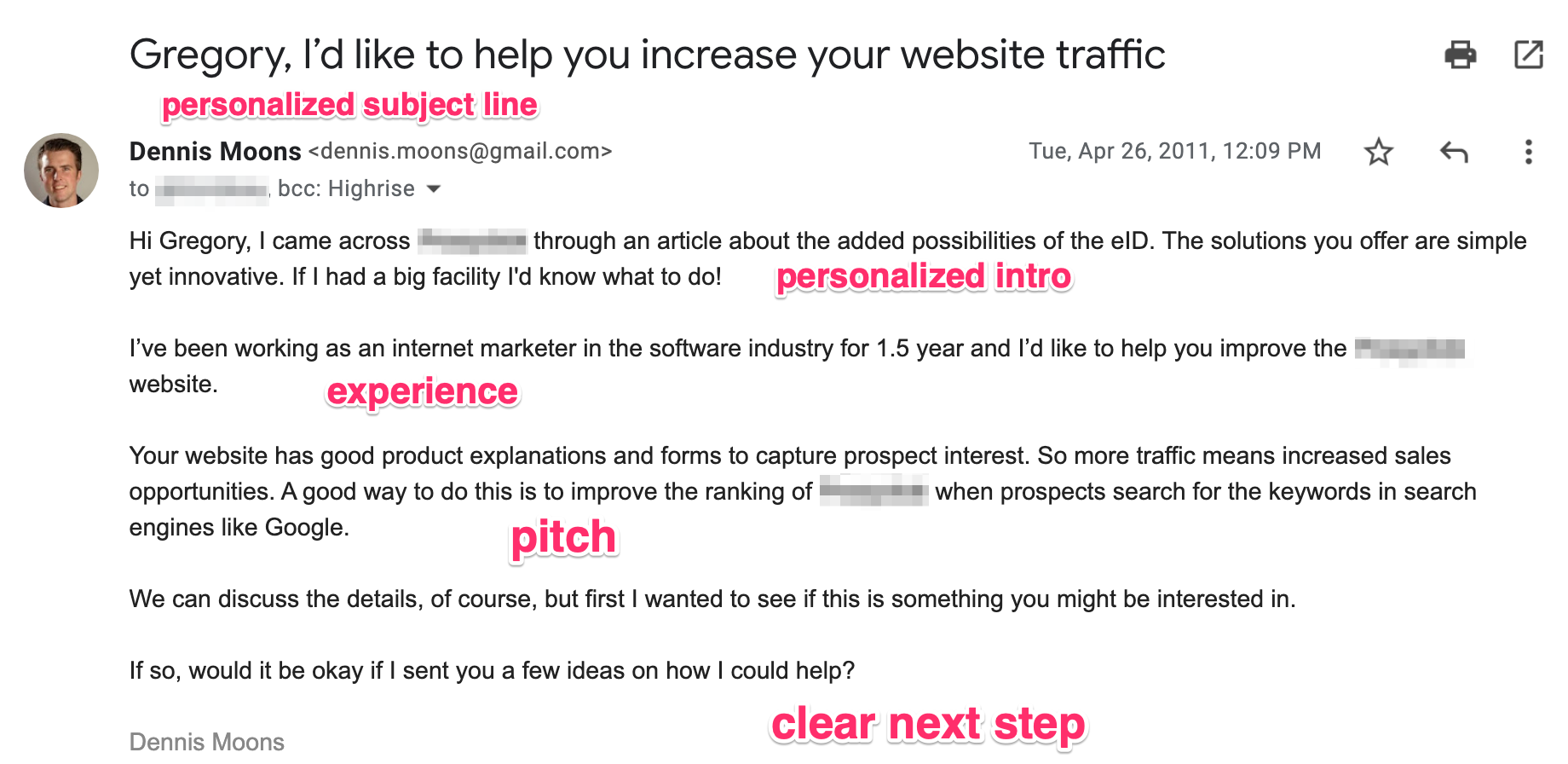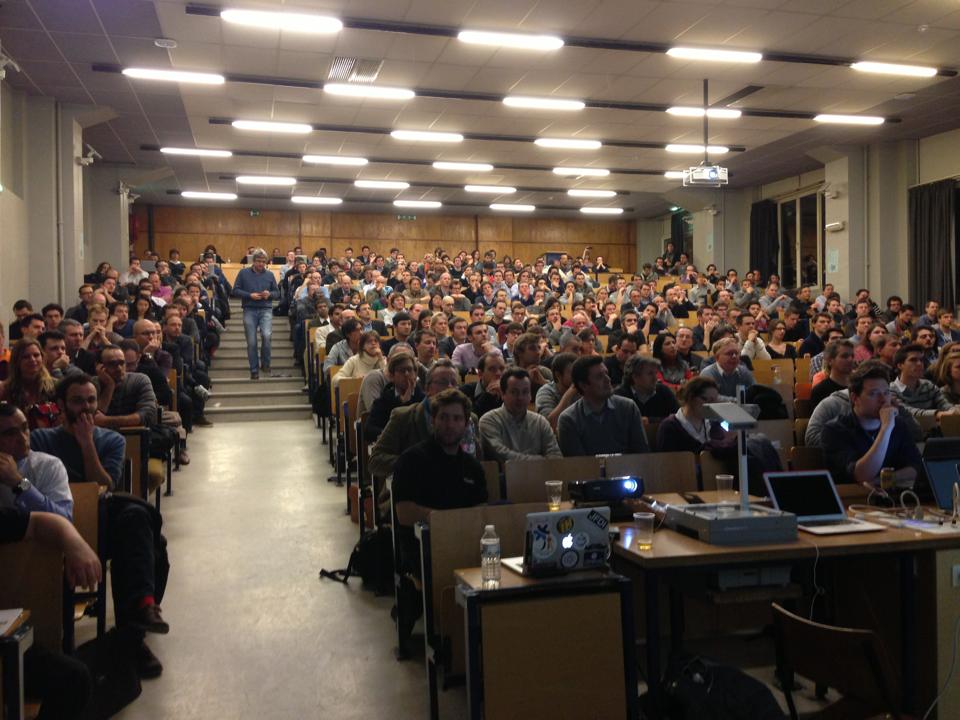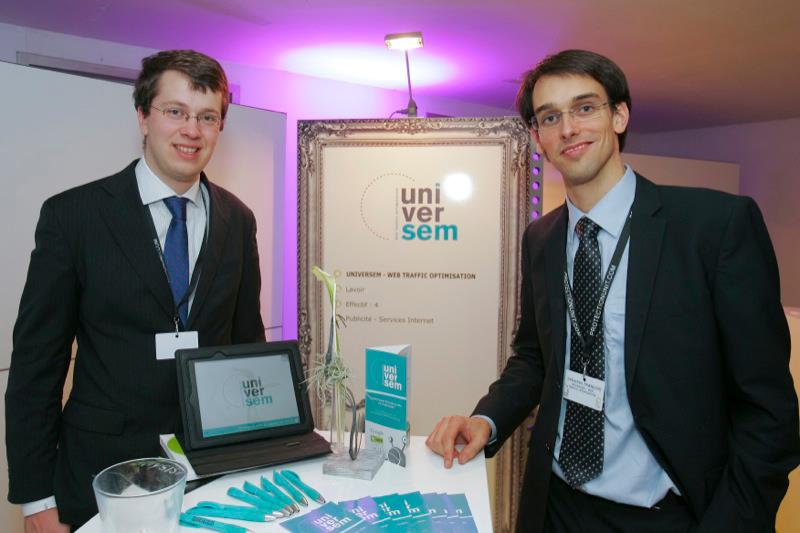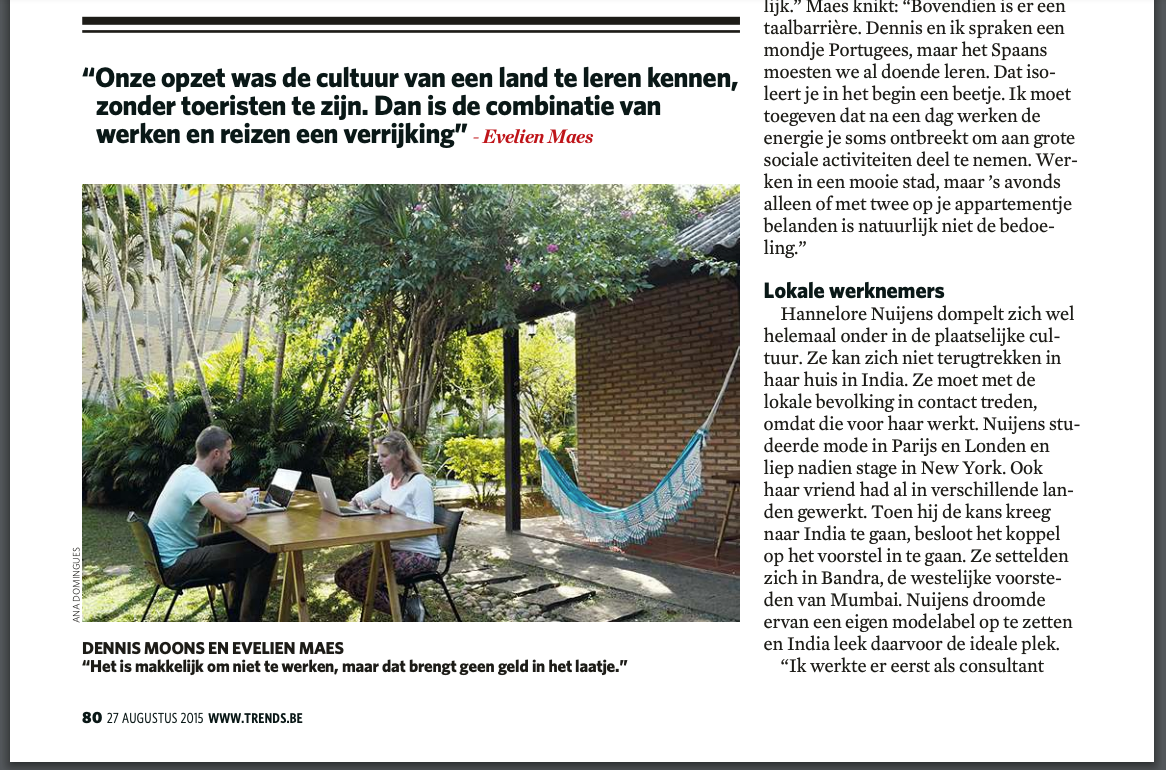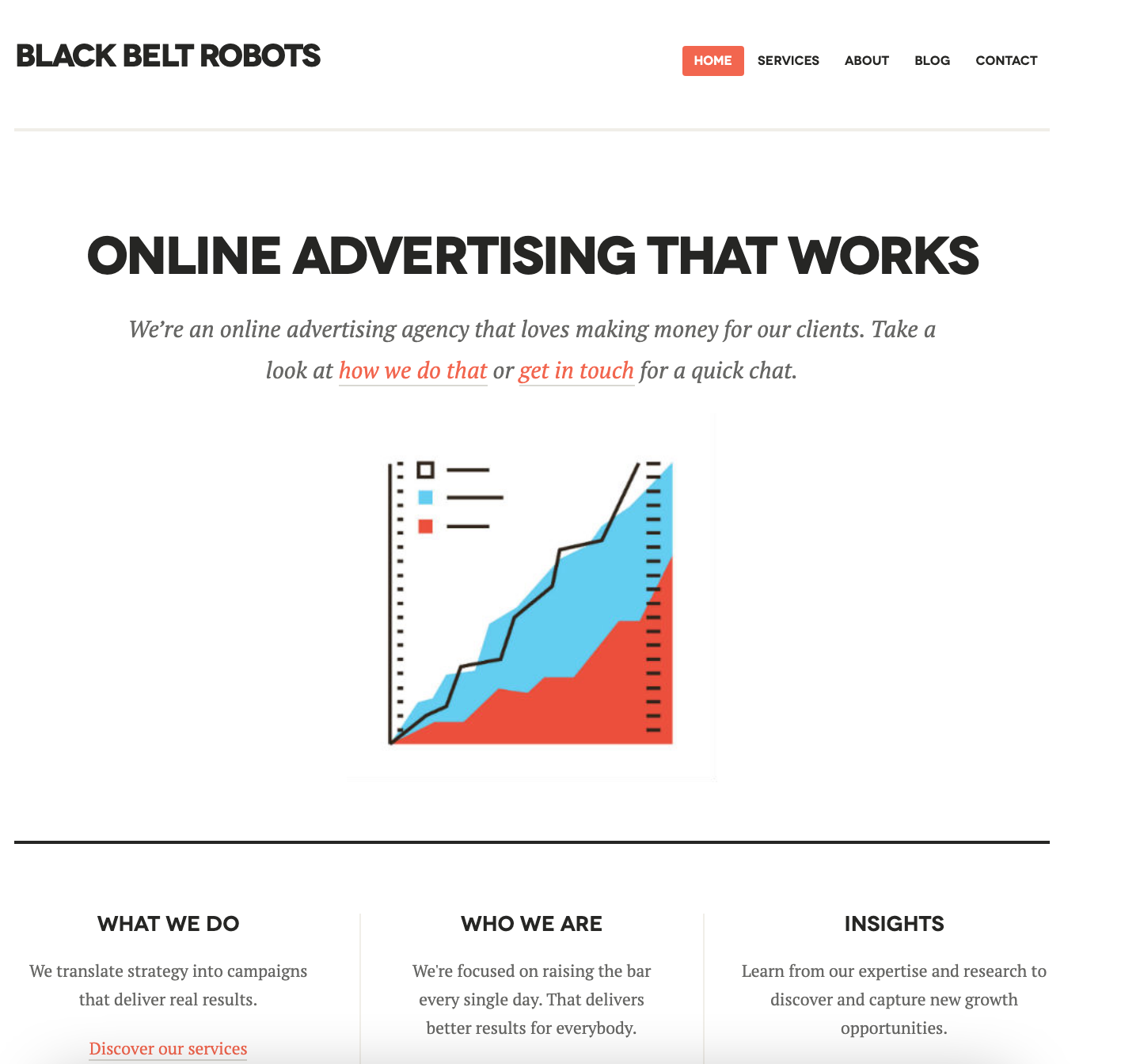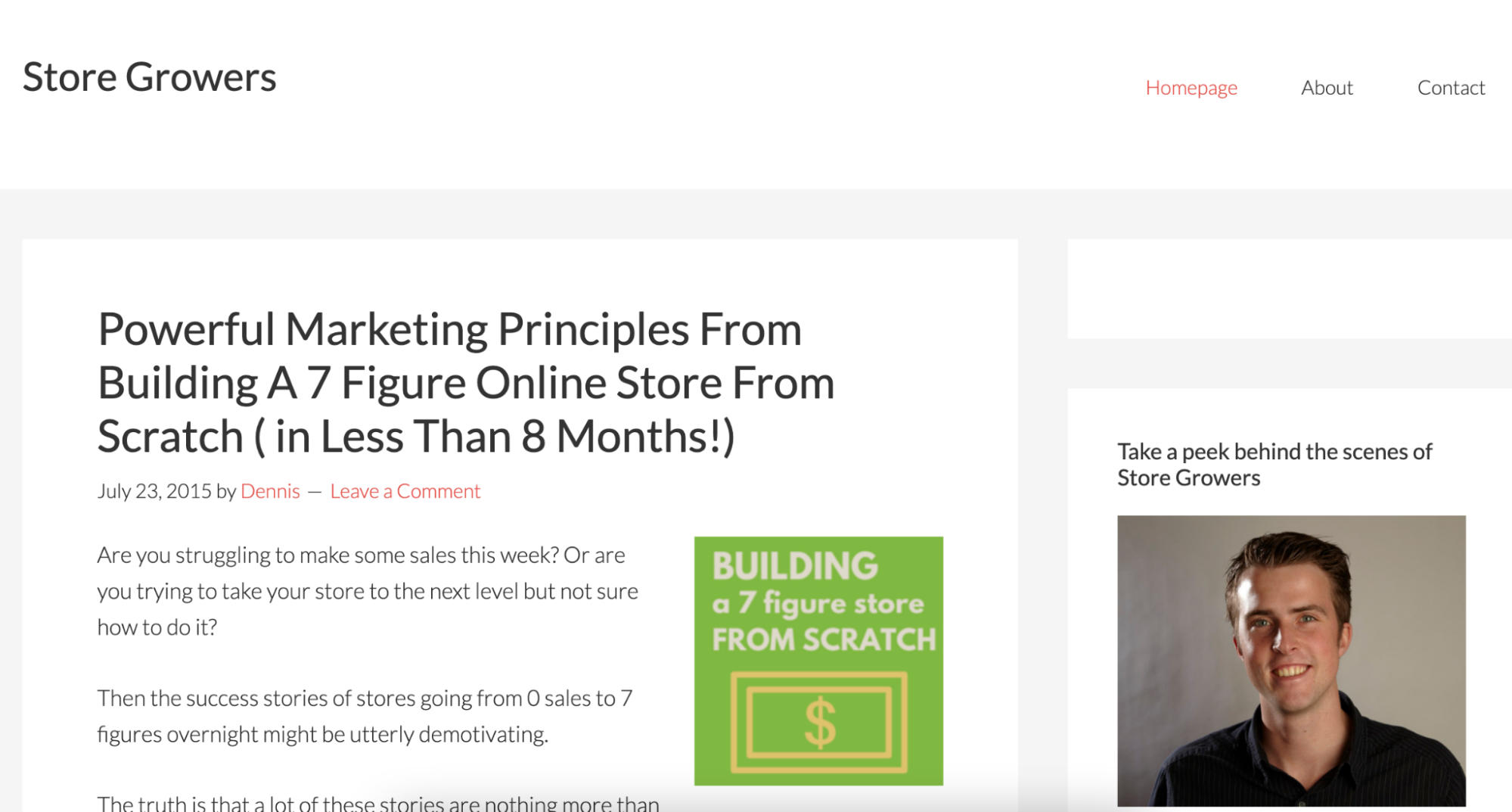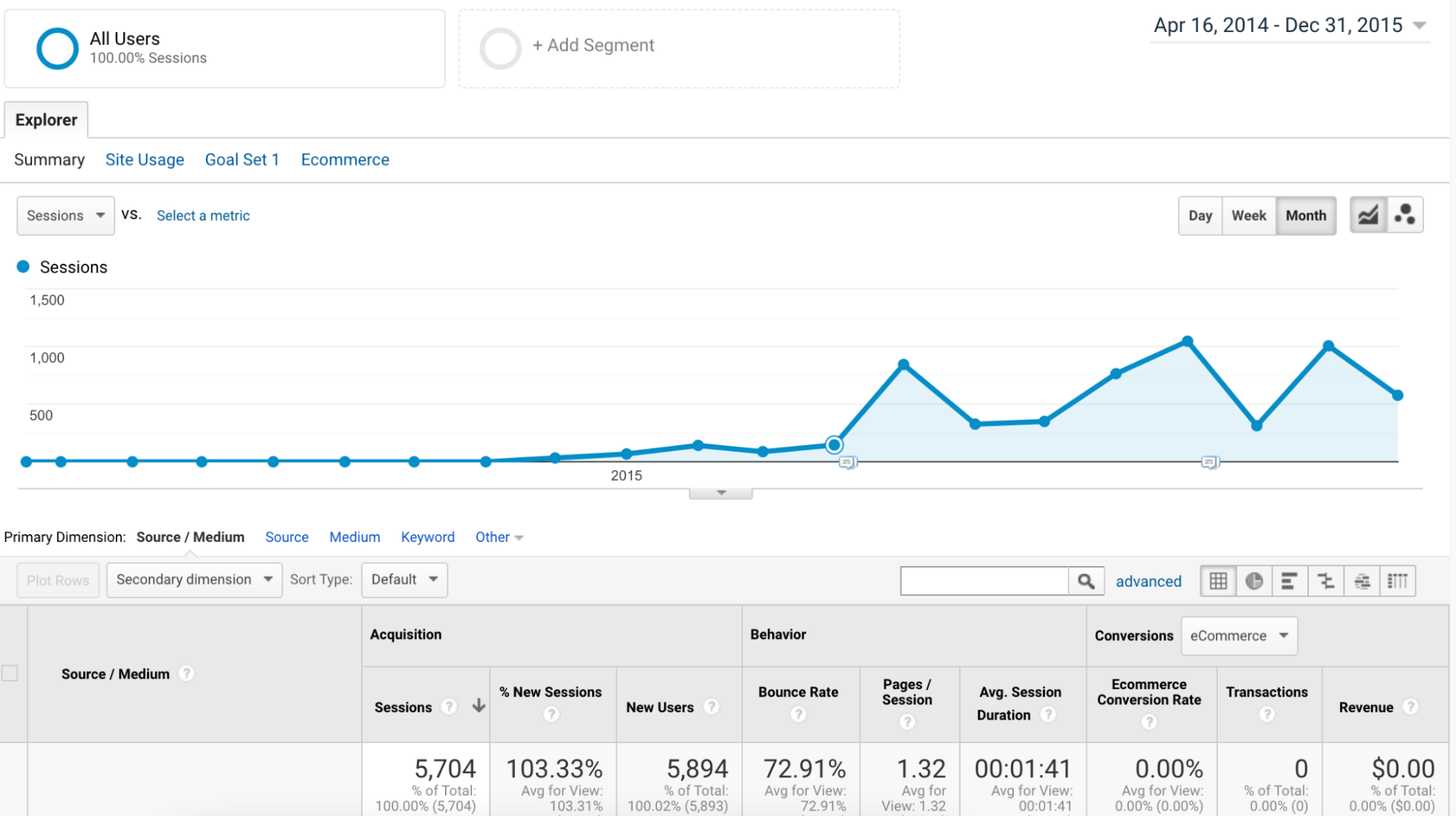2023 marked my 10 year anniversary as an independent consultant.
Thinking back about these 10 years, I realized a lot has happened!
So in this article, I’d like to take you through my journey of starting out as a jack of all trades freelancer, all the way to becoming an international Google Ads expert.
I’ll share some of the lessons I learned as I became better at my craft and better at business in general.
I’m confident that talking about all the mistakes I made will help you accelerate your own journey.
Let’s get started!
The Passive Income Dream (2011)
In 2011, I arrived back home in Belgium after spending 1.5 years doing an internship in Brazil.
During that time, most of my friends had gotten comfy jobs. But even a few years in I could start to see the cracks of the traditional career path: jobs weren’t that fulfilling, extreme hours, etc.
So instead of looking for a similar job, I figured I would try to go out on my own.
My biggest inspiration during that time was The 4 Hour Workweek, a book by Tim Ferris.
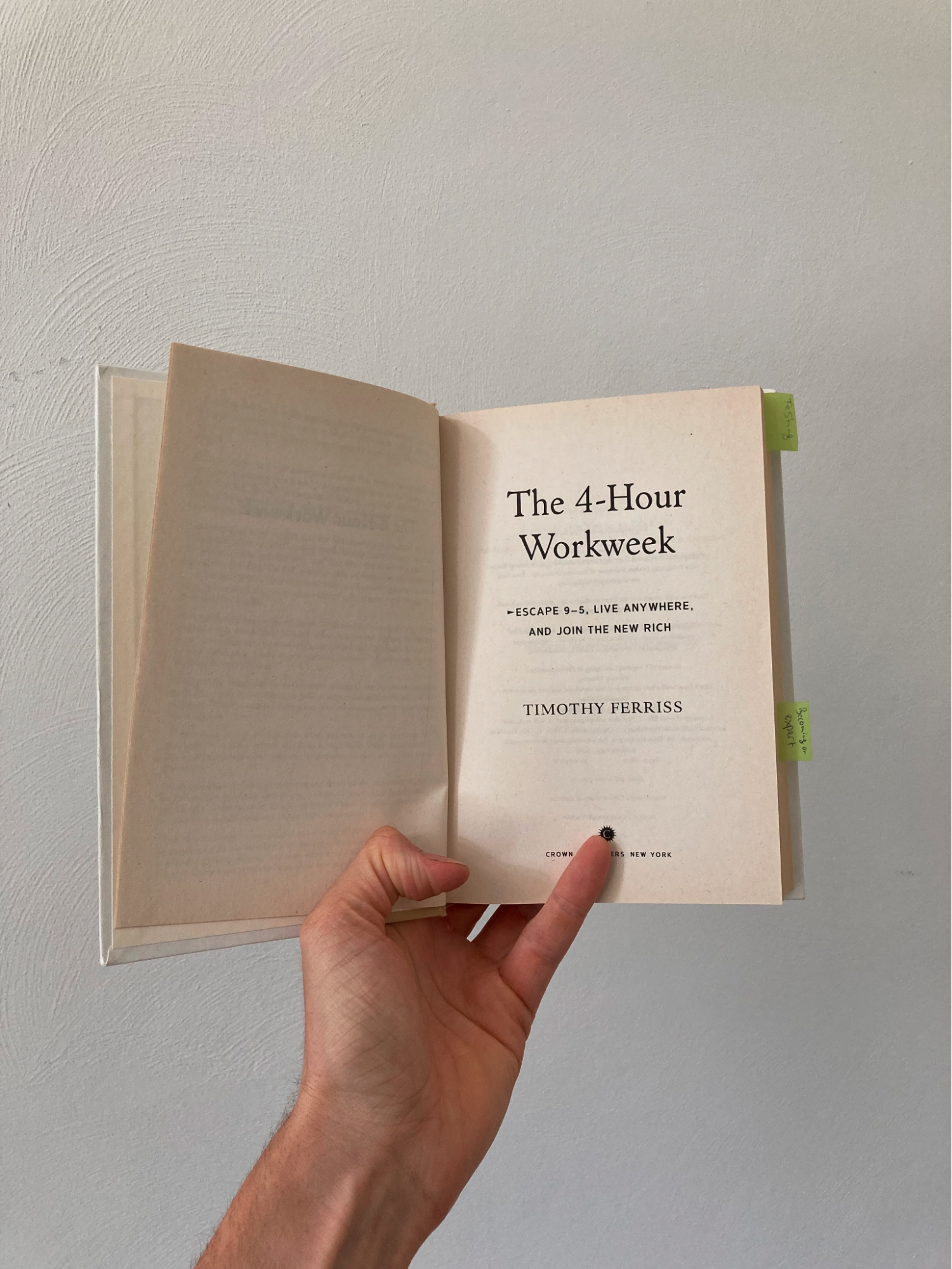
If you haven’t read it: it basically boils down to setting up a business that runs on autopilot. Decoupling revenue from the time you spend on the business.
This sounded great, so for a few months, I pursued all kinds of ideas: chewing gum for runners, supplements for endurance athletes, importing electronics, etc.
After 3 months of putting in very long hours, I had made exactly €0, nor did I have any prospects of making a living.
So instead of pursuing radical new business ideas, I started thinking about what I could do to make money tomorrow.
The only thing on my list was the skills that I had picked up during my Brazilian internship.
In that company, I had been doing all kinds of online marketing things.
So I shifted my focus in that direction.
Foolish Freelancer (2011)
When I decided I was going to be a freelancer, I didn’t really have any contacts or know people that could potentially hire me.
So to make a living, I needed to find those clients myself.
This was my approach to finding them:
- Create a list of Belgian software companies (I had some experience here)
- Find contact details
- Send email (see an example below)
- Follow-up via email/phone
- Get meeting
- Pitch services
Here is an example of such an email:
Even though I got ok response rates on the emails I sent out, I really felt I was going nowhere.
The main reason for that was the rejection, coupled with the feeling that no one really wanted what I had to offer.
I dreaded getting started in the morning.
But even though I hated doing it, I did manage to secure my first “pitch meeting”.
I went to the headquarters of that company and did a whole presentation on what they could do to improve their marketing.
A day later I followed up with a $150 proposal for an SEO project.
Here is the OG version of that:
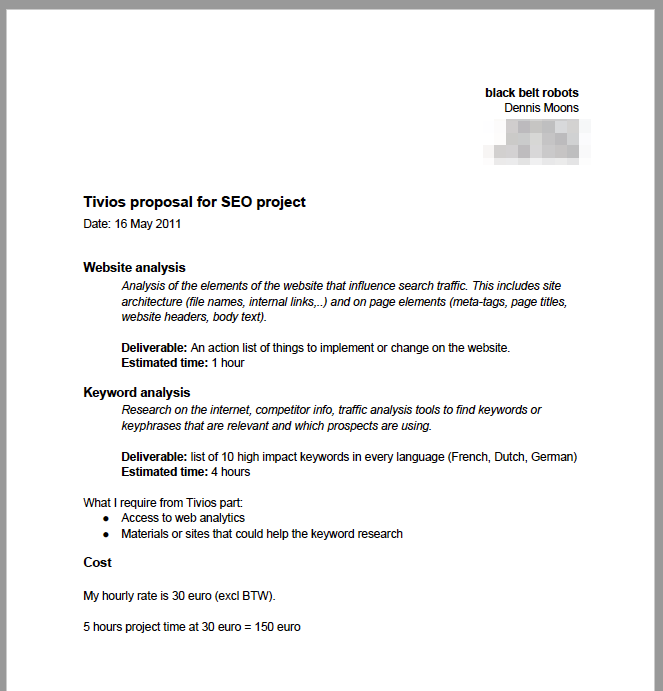
This first project came 4 months after starting my business, and about a month after I had gotten serious about freelancing.
My hourly rate at this point? $30/hour.
Lesson: Instead of trying to come up with a world-changing innovative business idea, focus on what you already know (skills, industry knowledge, contacts, etc.)
Sidenote: after this initial project, I kept working with this client for many years. In the end, sending out that cold email probably resulted in close to 6 figures in revenue!
I realize there is a lot of luck involved so wouldn’t recommend this strategy 😅
Subcontracting (2011 – 2020)
Trying to find and close clients through this outreach also engrained an aversion for cold calling in me.
Even if you’re successful at this strategy, the “success rates” are so low that you’ll have to deal with rejection most of the time.
I found this to be very energy-draining.
At this point, I had found my first few clients, which brought in some money. But I still had a lot of free time.
I didn’t want to do more cold calling, so decided to use the free time I had to start networking. And for a couple of years, I probably attended every start-up event there was in Belgium.
Like the monthly Betagroup meetings in Brussels:
The picture above does not look very sexy. It’s basically just a room in a school.
But it was buzzing with ideas and energy. All entrepreneurs pursuing ideas and companies.
Although I didn’t realize it at the time, the contacts I made during these events would form the foundation of my network.
One of those contacts was Hubert, who’d started his marketing agency a year before.
Back then, their marketing agency, Universem, was mainly focused on the French-speaking part of Belgium, and they could use some support in Dutch (it’s my mother tongue).
So I started subcontracting for them, and have done so for a long time!
Working with this established agency not only helped me to earn more, but it also allowed me to work with a higher caliber of clients. Ones with more ambition and bigger budgets than the clients I could find on my own.
My hourly rate at this point: €40/hour
Lesson: stop trying to “sell” to people. If you’re just a solo operator, you can’t afford to do all of the education AND sell them.
Instead, work with businesses that already have more work than they can handle.
Bodyshopping (2012 – 2013)
Having a couple of clients of my own and adding some hours of subcontracting helped to fill my schedule.
I felt really busy.
But when I started tracking how I was spending my time, I was quite surprised.
If you plan to work an average of 8 hours, you figure you can do 8 clients per day and spend 1 hour on each.
Writing this I realize how naive that sounds. Switching costs and keeping recharged in between work means that a day that’s supposed to be 8 hours, will actually take 10-12 hours.
At the same time, I started getting requests for longer-term projects.
One such assignment led me to work 4 out of 5 days a week for a single client.
Although I technically was a freelancer, in reality, these assignments aren’t much different than being an employee.
You’re working on-site, and according to their schedule. “They want to do a 4-hour meeting? Great! That’s half a day gone!”
At first, this was a pretty great period. Working full days for one client meant less context switching, which allowed me to deliver better work in a shorter period of time.
Financially this also was a lot better. Rather than having empty spots in my calendar, I could now bill 8 hours, 4 days a week.
At an hourly rate of €50, that meant I was making €1600 a week. So for the first time in my career, I was actually making some money!
Lesson: As a freelancer, you’re responsible for every hour of your day. So pay close attention to where your time is going. If a task takes 2 hours, make sure you charge for 2!
Getting focused (2014)
As I outlined in the previous section, working almost full-time for a single client resulted in a healthy profit.
But after a few months, I started having second thoughts about it.
Being part of bigger clients also meant dealing with corporate whims and plans I didn’t always agree with.
But as the lowest-paid contractor, your ability to influence decisions is very limited. So it’s either accept the course or get out.
During all this time, I always kept one day a week to work on my own business.
That was nowhere enough, but it did kickstart some other things.
Because during that one day a week, I worked from a coworking space in Antwerp, called Burooz.
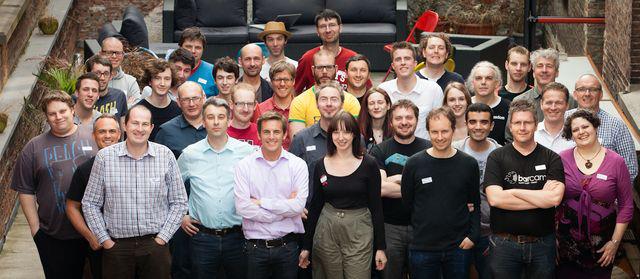
It was a good place to meet fellow entrepreneurs. And together with Kurt, the owner of the space, I helped to organize monthly mastermind sessions.
During these sessions, we got together with other members from the coworking space and gave each input and feedback on the challenges we were facing.
It was these discussions that helped me to shift into a higher gear, leading to a couple of BIG decisions.
First, I re-examined my business model.
Instead of selling my time by the hour, I was going to charge a fixed fee. So if I managed to do the work faster, my effective hourly rate would go up.
The second big decision had to do with the services I was going to offer.
Until that point in my career, I had helped clients with many different parts of online marketing:
- Search Engine Optimization (SEO)
- Social Media
- Email Marketing
- Conversion Rate Optimization
- Search Engine Advertising (SEA)
I was getting quite good results with Google Ads, so I decided to focus exclusively on running campaigns for clients.
The third big decision had to do with how (and where) I was working.
In 2014, I set out to travel the world together with my wife, while still working at the same time.
We spent almost two years on the road as digital nomads, switching places every couple of months: Brazil, Argentina, France, Indonesia, South Korea, and Thailand.
The stereotype of a digital nomad is someone sitting on a beach with a laptop.
But while the setting often looks very exotic, many people do work hard 🙂
Here is a picture of me and my wife when we were featured in a Belgian news article:
Even though I was far away from Belgium, I did manage to pick up new projects.
Both from my existing network, but also from people we met on the road. A lot of digital nomads work as freelancers, so there are plenty of opportunities to collaborate on client projects.
Hourly rate: €60/hour
Lesson: When you’re financially comfortable, it’s very easy to keep things as they are. But figuring out what you want out of life and following through on making that a reality is very rewarding.
Building an agency (2015 – 2016)
While I was on the road, the number of clients I was managing Google Ads for kept growing.
At one point I was managing 18 different Google Ads accounts. Which was pushing the limits of my sanity. (If you’re working with 18 different businesses, you can rest assured that there are always fires to put out!)
My ambition was to “build a real business”. So naturally, I needed to hire people to do the work for me.
Instead of hiring employees, I figured I would start with subcontractors. So naturally, I became an agency.
Here is what my website looked like back then:
Since I had all the contacts with the clients, the idea was that I would do the account management, and the subcontractors would do the actual work.
I had created a couple of processes, bought expensive Google Ads optimization software, and put a clear routine in place.
But after 6-7 months of experimenting with different subcontractors, it became clear that this wouldn’t work.
Even though more money was coming in, clients were upset because results weren’t there, I was working harder than before and my bank balance was dwindling.
At the time I didn’t really understand why the agency thing wasn’t working. So I internalized that working with employees wasn’t for me.
Since then, I have learned what the problem was.
- I didn’t have the right processes
- I didn’t have the right people
- I didn’t have the right financials (aka was charging too little)
The business just wasn’t ready to add more people.
This great Twitter thread by Sean McCabe sums it up pretty well:
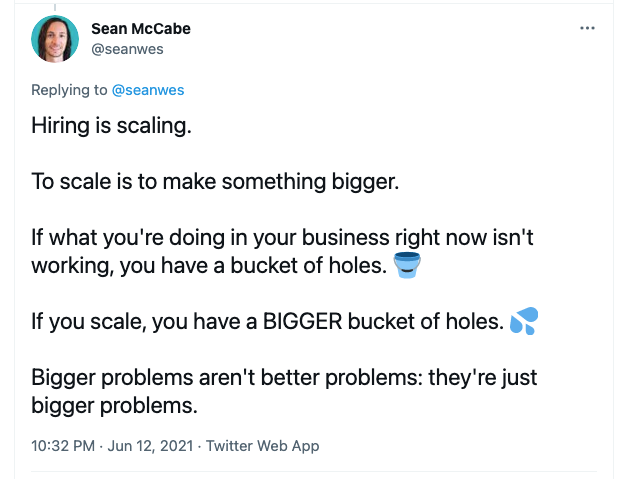
At this point, I started charging clients a fixed monthly retainer, like $500/mo, to manage their ad campaigns.
I tried to stay away from hourly rates in client discussions. But internally I was still using one to calculate costs.
Hourly rate: €60/hour
Lesson: Being a freelancer or building an agency are two worthwhile paths. But to be successful at one or the other requires clear choices and a clear strategy. Otherwise, you end up somewhere in the messy middle, which makes your life a lot harder.
Exploring Content Marketing (2015-2019)
After a failed attempt at building an agency, I decided I would go all in on being the best Google Ads freelancer I could be.
I knew that I had to niche down to increase my value (and rate!).
I had already picked Google Ads as my skill, now it was time to pick a specific audience.
From all the clients I had, my ecommerce clients were the most challenging and rewarding. Since there is a very clear link between what you do and its impact, there is no hiding.
So this accountability pushed me to keep improving my game.
To reposition my business, I rebranded as Store Growers.
In the past, I had always been writing blog posts and email newsletters, but with this new site, I really went for it.
I started to write long-form, in-depth articles on Google Ads.
And for the first few months, no one was reading.
During the first year of the site, 5704 people visited the site.
That’s 15 visitors per day.
This isn’t bad, but it certainly isn’t going to result in a flood of new client work!
In fact, only after 2 years of putting out monthly blog posts, I got the first lead from my website!
But even though progress was slow, I kept investing in the site, creating more and better content.
Today my website traffic is the lifeblood of my business.
I’ve got a healthy lead flow that would make many agencies jealous.
So looking back at it now, sharing my expertise was probably one of the most valuable things I’ve ever done.
But creating content means that you’re not earning money for clients.
So it’s important to strategically think about what you share and where you share it.
If your ideal clients aren’t on Instagram, it doesn’t matter if you spend 5 hours a day creating Stories.
Lesson: you don’t have to spend the time to build a blog and write articles. But if you want to share your expertise, you will have to invest time consistently to see results.
Bonus: Share your knowledge where other people already hang out. Like in a Facebook group or speaking during an (online) event.
Working With Winners (2019 – …)
In the years after, things became a lot easier.
I was focusing on a specific type of client which allowed me to get good results which helped me get referrals.
Besides that, my website was producing a steady stream of high-quality leads.
That meant that I was in a position to turn down clients.
I didn’t realize it at the time, but this is the moment when you can take your business to the next level!
Being able to turn down clients means freedom:
- You can choose which clients you work with
- Because you’re in high demand, you can increase your rates
- This means you could work less and earn the same (if you wanted)
- Etc.
Because you can be very selective about who you work with, it also enables you to do better work.
When I first started I wasn’t picky about which clients I worked with. If they wanted to work with me and could afford my fee, I was in.
Over the years, I became a bit pickier. About which types of businesses I would work for, which industries I wouldn’t.
Then it became more about whether or not I could learn something from a client.
Finally, the most important realization came from a book by Marshall Goldsmith. I don’t remember the exact words, but it went something like this:
If you want to be a successful coach, start working with successful people.
It seems almost too simple, but it is very true.
If you can only work with a single business, why not pick the business that has everything going right for them?
Since adhering to that rule, I’ve started working with a higher caliber of clients, delivered better results, and have generally enjoyed the work a lot more!
Hourly rate: €75-200/hour (although I would mostly work project-based)
Lesson: Pick the right clients. If you want to earn X, pick a client that can afford that rate. You might be able to sell a business on something too expensive. But if it’s not in their best interest, they aren’t going to stick around.
The Coach (2020 -…)
That brings me to where I’m at today.
I’m still working with a few select clients, they pay me a monthly retainer.
If you go to my contact page, you’ll see that I’m not looking for new clients.
Why is that?
After 10 years of being a Google Ads freelancer, I’m more interested in helping businesses on a different level.
I do more coaching, and with our courses I help companies to build up their skillset internally.
Hourly rate: $400 / hour
I’m not going to lie, if you charge $400 per hour, it significantly cuts down the number of people that are interested in working together.
So why charge so much?
The simplest reason is that I know I can deliver the value. I’ve worked with hundreds of clients and have managed millions in ad spend. So for the businesses that I do work with, I’m confident I produce a lot more value compared to what they’re paying.
The second reason is all about signaling, which might sound a little self-serving.
But if you’re a business owner, you’re going to treat someone you’re paying $400/hour very differently compared to $30/hour.
This doesn’t mean you should be a jerk to people that are earning $30/hour. Not at all!
At $30/hour, your day-to-day work is mainly focused on execution. You might have great ideas. But you lack the expertise and influence to sell them effectively to the people that have the authority or budget.
But at $400/hour, executives want to hear those great ideas. Or they might need you to help shape theirs!
Lesson: the amount a business is paying you relative to their overall revenue will determine the impact you can have. This doesn’t mean you always have to aim to charge the maximum amount you can every time. But I have found that clients that pay higher rates generally are nicer to work with compared to clients that pay lower rates.
What’s next?
While writing this post, I kept thinking about how much faster I could progress if I had known all of this when starting.
In fact, I had a pretty good view of this when my wife became a freelancer herself. About 5 years ago, she took a lot of these lessons and applied them.
She’s super smart and a quick learner, and today she is earning over 6 figures a year as a freelancer.
That was a reminder of the transformation that the right information can help someone accomplish.
If you’re still reading, thank you 🙏
Let me know in the comments what you learned that can improve your business 👇
